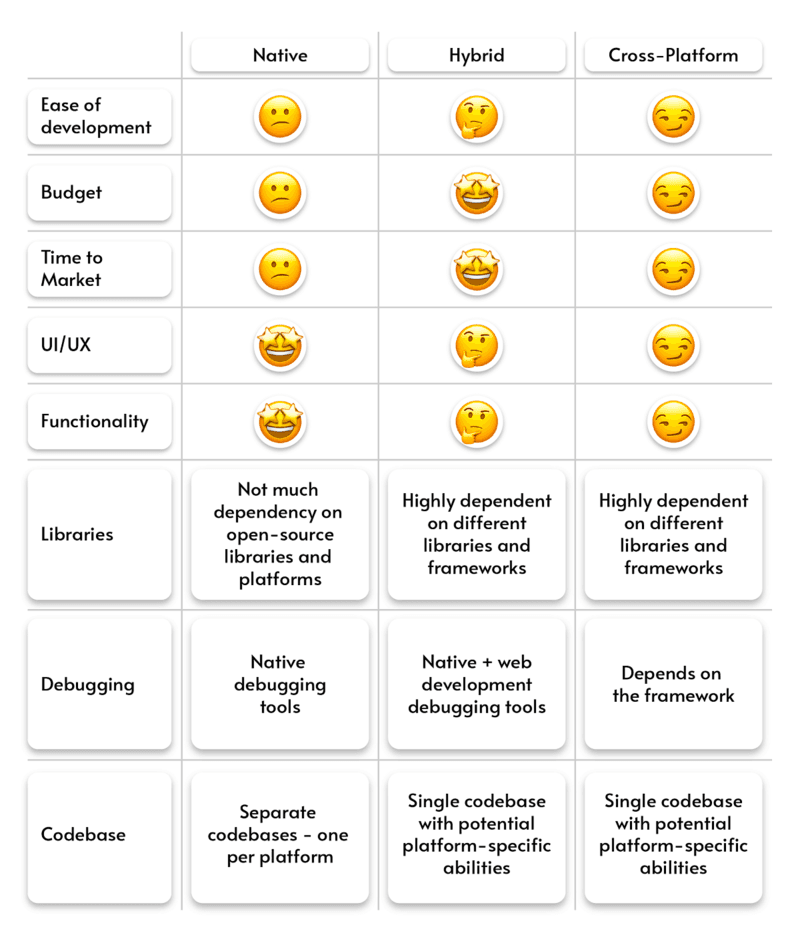Nowadays mobile applications are a must-be thing in most businesses. The first step to creating an app is to choose a development approach, which would be productive, functional, and, of course, cost-effective. So, we are here to simplify your choice by considering a few popular development options (Native vs. Hybrid vs. Cross-Platform).
Native Apps
The term refers to the creation of a mobile application exclusively for a single platform (Android or iOS). The development process is built on using programming languages recommended by the creators of the operating systems (Java or Kotlin for Android and Swift/Objective-C for iOS).
Pros of native app development:
-
Advanced functionality. Your developers get full access to OS’s features (API and tools) and are able to create a secured and user-friendly application with powerful performance;
-
Better store support. Publishing such apps to the App Store or Play Market is much easier. Moreover, native products are usually ranked higher on these platforms;
-
High performance and great UX. The interaction between software and hardware is easy and provides users with great performance. Furthermore, clients get a better user experience because native apps primarily have excellent interfaces and appearance (it is achieved through the use of Native UI).
Unfortunately, sometimes it is impossible to take advantage of the Native approach due to its costs: you have to hire iOS and Android developers if planning to launch an app on both of these OS.
All cons:
-
Costly. Hiring iOS and Android developers is expensive;
-
Time Consuming. Developing takes a lot of time because two teams of developers have to work independently. Alas, code reuse is not possible;
-
Complex application support (you can't opt out of both development teams).
Hybrid App Development
The Hybrid approach is known as a cheaper option, which allows building an iOS and Android app simultaneously and in less time. The codebase includes the code lines written in HTML, CSS, JavaScript, and other languages. Then they are wrapped into a native container: the WebView or Crosswalk. The WebView is responsible for user experience and the interaction with hardware (cameras, GPS, etc.). Therefore, there are some limitations and restrictions related to the functionality and user interface. The rendering engine is a browser that slows down the system.
The pros are obvious:
-
Lower development costs;
-
Supporting different OSs at the same time (code reuse);
-
Adequate customization capabilities.
Cons:
-
Lower performance (however, users won’t struggle);
-
Inability to use certain operating system’s functions;
-
Lack of interaction with native applications.
The Hybrid approach may be really useful if your priority is development speed and cost reduction: it allows you to present your own application in the shortest possible time.
Cross-platform Applications
First of all, you should know that Hybrid and Cross-platform options are not the same things. The only similarity is code compatibility. So, the cross-platform dev approach implies the use of JavaScript language. Then the codebase is connected to native components with the help of special bridges.
The user experience and performance are close to native apps. The cross-platform development method offers seamless functionality, easy implementation, and cost-effective production. However, close-to-native UX is not native UX, you shouldn’t expect something outstanding.
The cross-platform approach uses different frameworks, so the functionality and performance depend on them.
Pros:
-
Developers write code just once and use it for all platforms;
-
Cross-platform applications are secure, stable, and easy to maintain and scale;
-
There are many frameworks, which help to achieve the native app-like quality;
-
Such apps feature a fast UI (is similar to Native);
-
Development is cost-effective.
Cons:
-
Cross-platform applications are not as fast as Native ones;
-
Not all OS features are available;
-
Poor interaction with other native apps.
Let’s Summarize
Before choosing a certain option, you should determine your goals, budget, and deadline.
-
A Native application is perfect if you have enough financial resources and time, and wish to create a wonderful solution. Maybe, you are planning to launch an app only for one platform that will save your money. You’ll be able to develop another version of the app later.
-
A Hybrid application is a good option if you are running a startup. In this case, you need a budget solution to create an app for both iOS and Android operating systems at the same time.
-
Cross-platform development is ideal if your business requires a high-quality application, which would work on multiple operating systems. This approach may save your budget. It is a golden mean between the above options, so you shouldn’t worry about performance and UX. Moreover, after a while, you can switch on the Native approach.
Below we have given a more detailed comparison of Native, Hybrid, and Cross-Platform approaches.

If your app doesn’t have specific features, you can save your company’s budget by giving preference to the Hybrid or Cross-Platform approach. Games, B2B, and content distribution apps are usually cross-platform.
In order to choose a suitable option, you should define:
-
your target audience;
-
the level of complexity of the app’s functionality;
-
whether you need native functionalities or not (features of devices and OS);
-
the UI/UX level.

Do you have difficulty choosing a particular approach? Feel free to contact us: our professional team is ready to consult you taking into consideration your goals and plans.
Perhaps, the article “What You Need to Know About Native and Cross-Platform Apps” will answer some of your questions.